Kaman HOK-1/HUK-1 Huskie
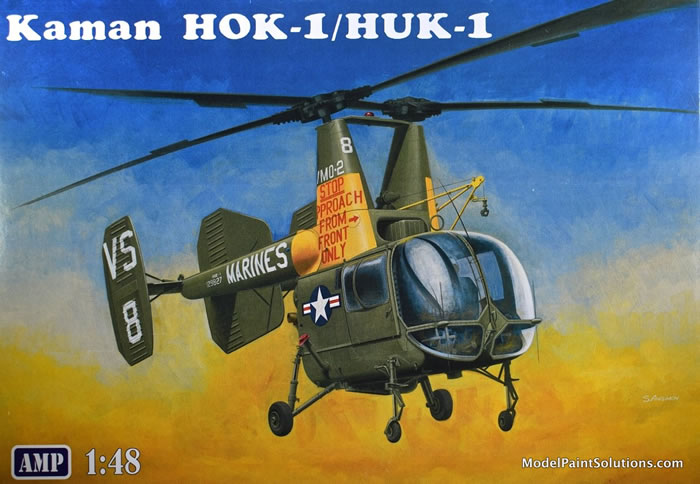
AMP, 1/48 scale
S
u m m a r y : |
Description and Item No.: |
AMP Kit No. 48013 -Kaman HOK-1/HUK-1 Huskie |
Contents and Media: |
133 parts in grey plastic; four resin parts; 11 clear parts; 46 in PE; die-cut masks; one decal sheet with markings for two airframes. |
Price: |
£31.33 Plus Shipping from Hannants
$48.16 Plus Shipping from HobbyLink Japan
and hobby retailers worldwide |
Scale: |
1/48 |
Review Type: |
First Look |
Advantages: |
This kit scores mighty high on the novel scale. Surface details (recessed and relief) are well done. There is very little flash and the level of detail provided in the cockpit and the resin engine/exhaust assemblies are just beautiful. A large PE fret (with seat harnesses), die-cut masks, and a well-printed decal sheet with markings for two Huskies rounds out a very nice offering from AMP. |
Disadvantages: |
The clear parts may require buffing/polishing for optimal clarity. |
Recommendation: |
I like this kit. The details are abundant and scale appropriate and the results will be clearly seen both externally (engine/exhausts) and through the large prominent canopy. The parts count isn’t low and there will be a lot of test fitting required but the result will surely be a head-turner not often seen at the local model show. |
Reviewed by John Miller

Airfix's 1/72 scale Sea King is available online from Squadron.com
The Kaman HH-43 Huskie was a helicopter with intermeshing rotors used by the United States Air Force, United States Navy, and the United States Marine Corps from the 1950s till the 1970s. It was primarily used for aircraft firefighting and rescue in the close vicinity of air bases, but was later used as a short-range overland search and rescue aircraft during the Vietnam War.
Under the aircraft designation system used by the U.S. Navy pre-1962, Navy and U.S. Marine Corps versions were originally designated as the HTK, HOK, or HUK, for their use as training, observation or utility aircraft, respectively.
Design and Development
In 1947 Anton Flettner, a German aviation engineer, was brought to the United States as part of Operation Paperclip. He was the developer of Germany's Flettner Fl 282 "Kolibri" (Hummingbird), a helicopter employing the "synchropter" principle of intermeshing rotors, a unique design principle that dispenses with the need for a tail rotor. Flettner settled in the U.S. and became the chief designer of the Kaman company, where he designed new helicopters using the synchropter principle.

The Huskie had an unusual intermeshing contra-rotating twin-rotor arrangement with control affected by servo-flaps. The first prototype flew in 1947 and was adopted by the US Navy with a piston engine. In 1954, in an experiment by Kaman and the US Navy, one HTK-1 was modified and flew with its piston engine replaced by two turbine engines, becoming the world's first twin-turbine helicopter. The Air Force later adopted a version with one turboshaft engine: HH-43B and F versions.
Operational History
This aircraft saw use in the Vietnam War with several detachments of the Pacific Air Rescue Center, the 33d, 36th, 37th, and 38th Air Rescue Squadrons, and the 40th Aerospace Rescue and Recovery Squadron, where the aircraft was known by its call sign moniker "Pedro". During the war, the two-pilot HH-43 Huskie flew more rescue missions than all other aircraft combined, because of its unique hovering capability. By the early 1970’t The HH-43 was replaced by newer aircraft.
Variants
-
K-240 - Company designation from HTK-1/TH-43E
-
XHTK-1 - Two two-seat aircraft for evaluation
-
HTK-1 - Three-seat production version for the United States Navy, later became TH-43E, 29 built
-
XHTK-1G - One example for evaluation by the United States Coast Guard
-
HTK-1K - One example for static tests as a drone
-
XHOK-1 - Prototype of United States Marine Corps version, two built
-
HOK-1 - United States Marine Corps version powered by a 600 hp R-1340-48 Wasp radial piston engine; later became OH-43D, 81 built
-
HUK-1 - United States Navy version of the HOK-1 with R-1340-52 radial piston engine; later became UH-43C, 24 built
-
H-43A - USAF version of the HOK-1; later became the HH-43A, 18 built
-
HH-43A - Post-1962 designation of the H-43A
-
H-43B - H-43A powered by an 860 shp Lycoming T-53-L-1B turboshaft engine, three-seats and full rescue equipment; later became HH-43B, 200-built
-
HH-43B - Post-1962 designation of the H-43B
-
UH-43C - Post-1962 designation of the HUK-1
-
OH-43D - Post-1962 designation of the HOK-1
-
TH-43E - Post-1962 designation of the HTK-1
-
HH-43F - HH-43B powered by an 825 shp T-53-L-11A turboshaft engine with reduced diameter rotors, 42 built and conversions from HH-43B
-
QH-43G - One OH-43D converted to drone configuration
The initial impression is one of complexity. There are a lot of small parts in this box and a fair number (46) are photo-etched. Close examination of the injected parts reveals a high level of detail with nicely recessed details and little flash.
The parts layout and engineering are conventional. There are many (many) sub-assemblies; each comprised multiple parts. This is not going to be a weekend build with most (all?) of the sub-assemblies requiring painting.
Surface detail is recessed and in relief where appropriate. Most of the recessed details are crisp and scale appropriate however some areas will require refreshing.
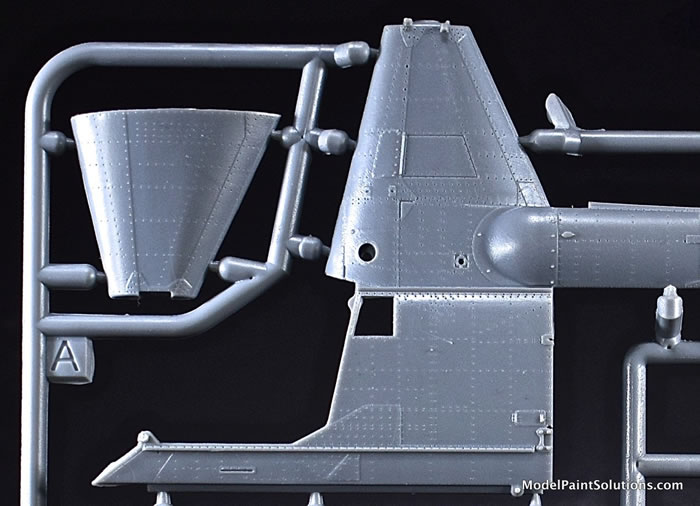
As usual, assembly begins with the cockpit where there is ample detail provided. The beautifully molded, multi-part instrument panel is augmented with photo-etched levers. Likewise, photo-etched belts are provided for the multi-part pilot and co-pilot seats. The nicely detailed twin rudder pedal assemblies and lower bulkhead, complete with multiple photo-etched stiffeners, will make the cockpit look very busy. There is a lot of detail here that will be clearly seen through the large, prominent canopy. More so if the sliding cockpit side doors are posed open which appears to be an option.

The completed cockpit is then trapped between the fuselage halves and the tail fins are added to the tail boom. The multiple tube supports and stiffeners around the tail fins will look impressive when assembled.
Next up is the engine and exhaust assemblies, which incorporate multiple, nicely cast, white resin parts.
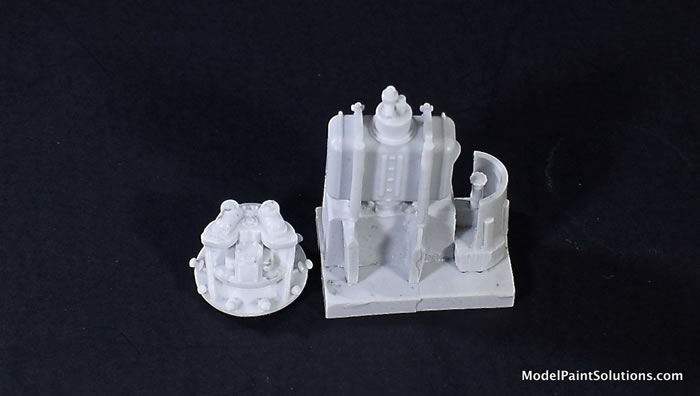
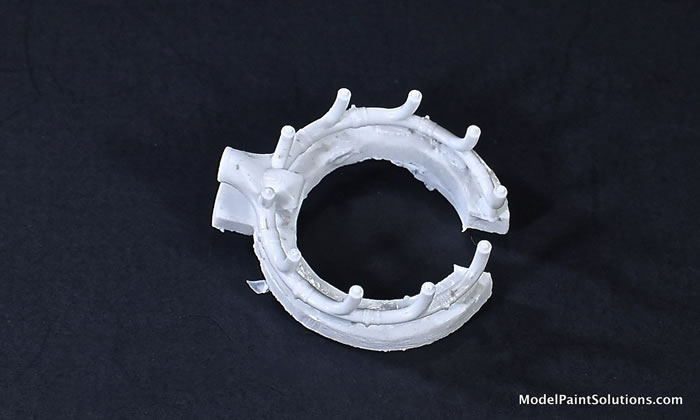
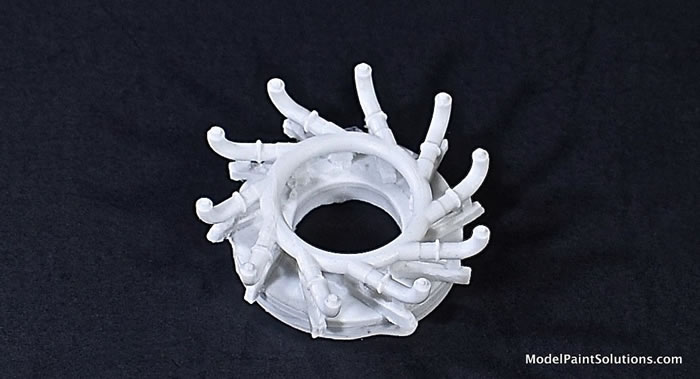
The engine/exhausts could serve as a model by itself. There’s a lot of room for super detailing here, as the assembly will be very visible on the completed model. The addition of the four nicely molded gear legs completes the main assembly.
The clear parts in my example are well cast but suffer from small scratches and cloudiness. A few minutes with a tissue and some Novus plastic polish revealed both issues are easily fixed.
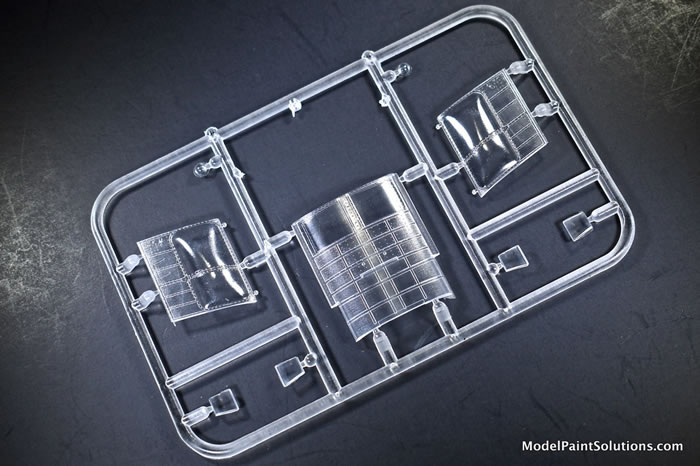
The main canopy is comprised of two-pieces glued down the middle. Care will have to be taken to ensure proper fit and alignment as well as a damage-free installation. Fortunately, a PE strip is provided that runs along the resulting seem and will go a long way to making the assembly clean.
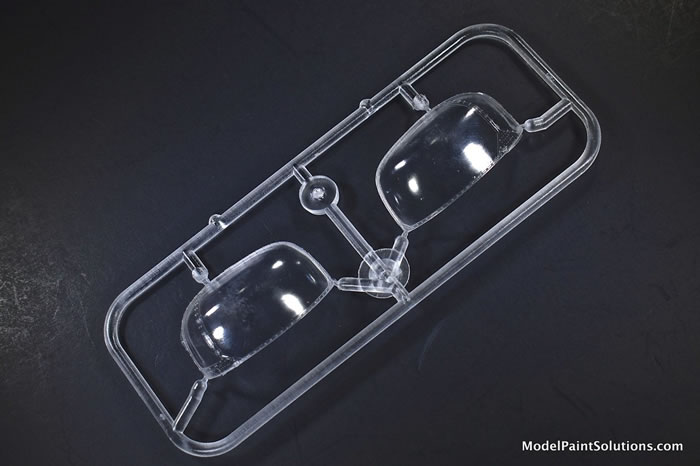
And, there you have it. I don’t see any big issues laying in wait nor do I anticipate a lot of time will be required for parts clean up; there’s very little flash. I do see a model that will most likely require a lot of test fitting and patience in order to get the most out of what’s in the box.
Marking Options
The decals, by AMP, are crisply printed with good registration, hue, and color density.
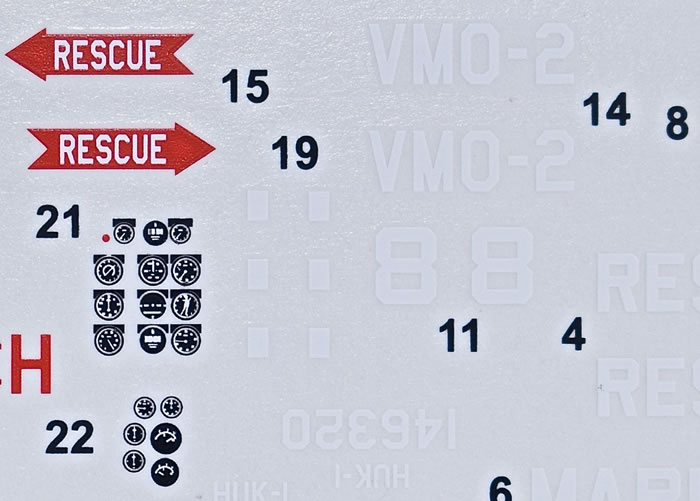
The white-colored markings on the sheet are best seen in the provided magnification.

Markings for 2 airframes are provided as follows:
-
HOK-1, U.S. Marines, VS-8
-
HUK-1, U.S. Navy, Atsugi Rescue
I like this kit.
Details are abundant and scale appropriate and the results will be clearly seen both externally (engine/exhausts) and through the large prominent canopy. The parts count isn’t low and there will be a lot of test fitting required but the result will surely be a head-turner not often seen at the local model show.
Review kit provided by my wallet.
For more on this review visit Modelpaintsolutions.com.
Text and Images Copyright © 2019 by Model Paint Solutions
Page Created 13 January, 2020
Last updated
13 January, 2020
Back to HyperScale Main Page
Back to Reviews Page

|
Home
| What's New |
Features |
Gallery |
Reviews |
Reference |
Forum |
Search